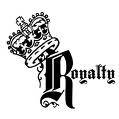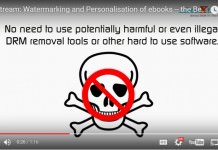 Tom Holland, chair of the UK’s Society of Authors, makes some excellent points in his talk to the Romantic Novelists’ Association’s annual conference, quoted in The Guardian. Holland says that ebook royalties should be considerably higher than the 25% they are now.
Tom Holland, chair of the UK’s Society of Authors, makes some excellent points in his talk to the Romantic Novelists’ Association’s annual conference, quoted in The Guardian. Holland says that ebook royalties should be considerably higher than the 25% they are now.
Holland agrees that publishers are incurring high costs right now as they put a digital infrastructure into place, but he says this will change once the project is done and warehousing and distribution costs diminish. He wants to go for a 50% royalty.
He makes an excellent point, that I haven’t heard before, about how publishers want flexibility to price but don’t want to give any flexibility to their authors:
“We accept that publishers have been investing heavily in digital infrastructure and at the moment they are losing money on ebooks because sales are so low. I can sort of understand their reservations over higher royalties at the moment, but nevertheless a contract that lasts for the duration of copyright is a hugely long time. Publishers in negotiations with Amazon, or whoever, say they want two-year contracts because there’s such flux, but at the same time are asking authors for the duration of copyright. It has to be wrong – it’s not remotely fair,” he said.
Much more in the article.


































I agree that eBook royalties should be higher than paper royalties. For the midlist author, paperback royalties are about 6% (of gross). 25% (of net?) is already a huge step up from that. I doubt that we’ll see 50% as industry standard any time soon. I’ve been 50% since the beginning and let me tell you, it doesn’t leave much to pay for editors, artists, marketing, composition, etc.
Rob Preece
Publisher
Interesting. Royalties from my publisher, Smashwords, are 85%. Retailers (Kobo, B&N, iBook, etc.) take a slightly bigger cut, but overall I make a nice amount per sale on my thriller “Pilate’s Cross.”
Actually, according to experts like Richard Curtis who watch the conglomerates, the industry standard is beginning to move toward 50%.
Rob, you’ve given yourself no wiggle room with your book for a buck pricing. Volume won’t always increase enough to handle those rising expenses. It never has in any business. That’s why price increases happen on everything.
It’s interesting how even authors are buying into the claims that publishers shouldn’t get as much money for e-books because they don’t cost as much to produce, whereas the publishers continue to insist that printing costs only amount to a small percentage of the total.
Writers need to take control of their own destiny and educate themselves about their position in the new publishing economy. They also need to accept their position and whether they want to sign up to be published at all costs.
The costs for the publishers are plummeting for ebooks. The ‘extra IT costs’ they claim to be incurring is for the most part a complete and utter fantasy.
However it is for the writers and the publishers to negotiate their own deals. If a writer has only one offer to publish him then they are not in a great position to negotiate. If they have more than one then they need to fight for what they want. It’s not an issue for the wider public imho.
Chris, for publishers the print versus ebook costs are essentially the same for acquisition, editing, pre-print file preparation, marketing, and publicity. Printing and binding costs have an inverse relationship to press run length and are generally fairly small for books projected to be mid list or higher. Creating ebooks in various formats after pre-print work is done is a small cost assuming an XML workflow leading up to it.
For print books, a publisher’s cost after printing include warehousing, distribution, and the returns system. For ebooks the costs after printing may include DRM fees, but not a lot else that is significant.
For a print book, a publisher can project all costs pretty accurately, and so set a retail price which will recover those costs plus a small margin if, say, 70% of the print run sells through within a given period of time.
That calculation cannot (yet) be made with any degree of certainty for ebooks. Probably the best one can do is calculate the net receipts per unit sold by each ebook retailer, add the author’s royalty %, and divide the result into the known costs of getting unit #1 of the ebook produced. That will tell you how many copies must sell to break even on your investment. But with the market being as new as it is, you may as well throw darts at random numbers to figure out what time it will take to achieve that break even sale.
My feeling is that authors and publishers would be best served if they talked through this, instead of taking positions and sniping at each other. The solution could well rest in transparency: instead of a publisher saying to an author, here is my contract offering you X% of net receipts for ever, a publisher might say: I have run the numbers and here is my projected cost of taking your new ebook to market; here is the number of copies we need to sell to recover that investment. Let’s begin with a royalty of X% on receipts. When we have recovered our initial outlay, your royalty will increase to Y% (and perhaps a third jump, to Z% which might be > 50% could be added for sales beyond a third target number).
Publishers could also adjust their contract terms such that, if unit sales drop below a certain number for, say, two consecutive years, the author would have an uncontested option to take back rights on the title and either sell it themselves, or seek a new publisher.
I know this is a “different” way of looking at royalties and author contracts, but I think it could be a lot better for both parties. Staying in the old box because it is comfortable is not the way to deal with disruptive change.
Chris, in the above post I intentionally omitted a cost-of-money calculation, although it can be quite significant, because I wanted to keep the model simple.
In the fourth paragraph I did not add a key item (mistake!). I should have noted that after calculating the net receipts per unit sold, per each different retailer of the ebooks, one should calculate the average receipts for a single unit sold.
May I say an excellent post Ric. You essentially stated most of the position, accurately, and in a nutshell.
We need to remember that except for top sellers they still have to guess how many will be sold. They may know the costs but not the likely revenue.
I agree that things have changed in this process in the eBook market. Publishers cannot guess how many will sell through the eBook pipeline because the whole business is in it’s infancy.
However the only sunken cost that needs to be assessed in advance is essentially the marketing budget. All other costs to the point of sale are basically unchanged. With no print run there is no print run costs.
I don’t believe it is as difficult as you infer however. They are still selling mostly in hard copy, and eBook sales are just as sensitive to marketing as hard copy sales.
The problem I see here is that Publishers are not really walking the walk through this process in a new mind-set way. They are blundering on pretending nothing has changed while charging a price for eBooks that is causing a ripple effect through the buying public that will be hard to reverse when when they wake up to the error of their ways.
Ric, I believe you. The problem is, as an article I subsequently blogged about notes (and commenters chime in to agree), most people don’t buy it. Which means there’s going to be quite a bit of commotion over it until one side or the other can be convinced to change its outlook.
Howard, publishers generally can make fairly accurate projections of sales for mid-list titles; one is occasionally surprised by a book going way over or under, but not that often in my experience.
I disagree on the sunken cost issue, for two reasons: (1) if you are publishing print and ebook versions of a title, you must assume that sales will be divided between the two formats, so in that case you would have a more complex set of calculations, with some portion of costs assigned to each. (2) I think as the ebook market grows, there will be a rapid shift towards ebook-first, print version if the tile does exceptionally well. I expect to start publishing some titles e-book first later this year. My costing models outlined in the previous post were based on an ebook first approach for sake of simplicity.
Chris, no question that a great many people don’t buy it. I do think publishers need to be more open/transparent on these issues with the authors they work with. Authors also need to understand that once they go beyond the big conglomerate publishers, the rest of the publishing industry is small to very small companies run by book fanatics working on wafer-thin margins. I’ve worked in both environments in senior management; I currently work by choice in a very small book publishing company, earn a little less than 10% of what I did in the multinational and fly coach instead of first, and nothing would persuade me to go back. I really believe that publishing is an industry best-suited to being small scale, where the relationship between the publisher and the author is personal; the attempts to make publishing an assembly line process have caused a fair number of the problems the industry faces today.